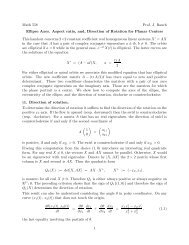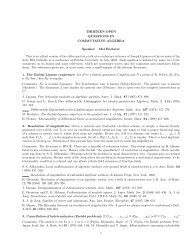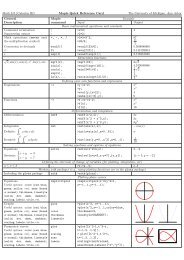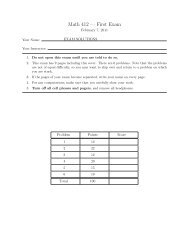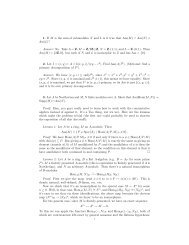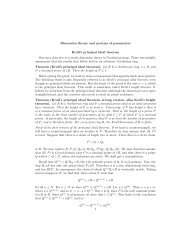Fronts Propagating with Curvature- Dependent Speed: Algorithms ...
Fronts Propagating with Curvature- Dependent Speed: Algorithms ...
Fronts Propagating with Curvature- Dependent Speed: Algorithms ...
Create successful ePaper yourself
Turn your PDF publications into a flip-book with our unique Google optimized e-Paper software.
ALGORITHMS FOR SURFACE MOTION PROBLEMS 13<br />
equations of motion of propagating fronts, which resemble Hamilton-Jacobi<br />
equations <strong>with</strong> viscosity terms. We demonstrate our algorithms by camputing t<br />
solutions to a variety of surface motion problems.<br />
The background theory and numerical experimentation behind this approach<br />
have been developed in a series of papers, see 1131-341. In this paper, these ideas<br />
are coupled to the technology for the numerical approximation of hyperbolic con-<br />
servation laws to produce algorithms which we call PSC schemes, for propagation<br />
of surfaces under curvature. These new schemes allow one to follow the motion of<br />
an N-l dimensional surface in N space dimensions. The speed may be an arbitrary<br />
function of the curvature, and the front also can be passively advected by an<br />
underlying flow. The algorithms can be constructed <strong>with</strong> any desired accuracy in<br />
space and time and do not require the front to remain a function. The metho<br />
set in an Eulerian framework; thus the number of computational elements is<br />
at the outset. Topological merging and breaking is handled naturally, and th<br />
first-order scheme is extremely simple to program.<br />
As illustration of the wide applicability of such algorithms, consider the case of<br />
flame propagation, see [34]. A common model idealizes the burning flame as an<br />
infinitely thin boundary which separates regions of constant steady-state velocity,<br />
density, and temperature, and propagates into the unburnt fluid at a speed depen-<br />
dent on the local curvature. The idea here is that cool convex fingers reaching out<br />
into the unburnt gas somehow propagate slower than do concave regions whi<br />
hot gases surrounding a small unburnt pocket. At the same time, particles alo<br />
flame front undergo an increase in volume as they burn, creating a jump in velocity<br />
across the flame front. This discontinuity in the velocity field creates vorticity along<br />
the burning flame, which can be related to the local curvature, and this new vor-<br />
ticity field contributes to the advection of the propagating flame. Thus, there are at<br />
least two distinct ways in which the speed of the moving flame depends on the local<br />
curvature.<br />
Typically, there have been two types of numerical algorithms employed in<br />
solution of such problems. The first parametrizes the moving front by some vari<br />
and discretizes this parametrization into a set of marker points [39]. The posit<br />
of the marker points are updated in time according to approximations to<br />
equations of motion. Such techniques can be extremely accurate in the attempt to<br />
follow the motions of small perturbations. However, for large, complex motion<br />
several problems soon occur. First, marker particles come together in regions where<br />
the curvature of the propagating front builds, causing numerical instability unless a<br />
regridding technique is employed. The regridding mechanism usually contains an<br />
error term which resembles diffusion and dominates the real effects of curvature<br />
under analysis. Second, such methods suffer from topological problems; w<br />
regions “burn” together to form a single one, ad hoc techniques to eliminate parts<br />
of the boundary are required to make the algorithm work.<br />
other algorithms commonly employed fall under the category of “volume of<br />
fluid” techniques, which, rather than track the boundary of the propagating front,<br />
track the motion of the interior region. An example of this type of algorithm is



